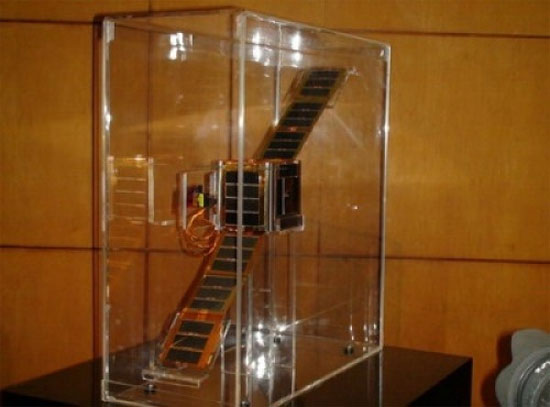Satellite Ecuador collided with Soviet missile fragments
The Pegaso satellite - the first satellite built by Ecuador and recently put into orbit last April, collided with the remaining pieces of a Soviet-launched missile in space in 1985, but it did 'survived' after this collision.
Director of the Ecuadorian Civil Space Agency (Exa), Ronnie Nader, confirmed that the incident occurred on the morning of May 23, and said that the Pegaso continued broadcasting, but on the ground did not receive credit. signal, because after the incident on the satellite of the satellite is not directed towards the Earth.

Pegaso satellite before being put into orbit. (Source: Wikipedia)
He also said that because the Pegaso shell is made of solid material and the pieces of missiles are so small that the collision does not destroy the satellite. Exa hopes that after 3 months, the problem will be overcome.
An Argentinian satellite that was launched into orbit with Pegaso by Chinese boosters on April 26 was similarly affected.
Pegaso was launched into orbit from a Chinese space center. From May 16, Exa received a video signal from the satellite. So far satellite has sent Earth images of geographic regions in some South American countries like Brazil, Colombia, Ecuador, Peru and Venezuela.
This is a micro satellite, weighing only 1.2kg. The Pegaso 'twin' satellite, Krysaor, will be launched into orbit from a space center in Russia in August.
Exa and some private businesses have invested 80,000 USD to build these two satellites. For its part, the Ecuadorian government spent $ 700,000 to cover the cost of launching orbits, insurance, and other logistics costs.
The launch of Pegaso to orbit marked an important development in Ecuador's attempt to conquer space.
- Soviet satellites fell to earth
- Ecuador tried to save the satellite and hit the universe
- Satellite fragments began to fall to the earth
- Russia launches Proton-M missile carrying Dutch satellite
- Space waste - threat exists
- The first half-century satellite of humankind
- Discover Russia's unique 'unique' rockets once
- Discover the secret bases of the Soviet Union
- India and Venezuela launched satellites into orbit
- Headache of satellite security
- Fragments of Chinese satellite fall to the field
- NASA destroyed the missile after the failed launch
 Van Allen's belt and evidence that the Apollo 11 mission to the Moon was myth
Van Allen's belt and evidence that the Apollo 11 mission to the Moon was myth The levels of civilization in the universe (Kardashev scale)
The levels of civilization in the universe (Kardashev scale) Today Mars, the sun and the Earth are aligned
Today Mars, the sun and the Earth are aligned The Amazon owner announced a secret plan to build a space base for thousands of people
The Amazon owner announced a secret plan to build a space base for thousands of people Artificial satellite missing for 40 years suddenly returns, leaving scientists bewildered
Artificial satellite missing for 40 years suddenly returns, leaving scientists bewildered  What exactly is the space signal detected by Tesla?
What exactly is the space signal detected by Tesla?  Satellite debris poses a serious threat to the atmosphere
Satellite debris poses a serious threat to the atmosphere  Declassified spy satellite, 1,400-year-old ghost town appears
Declassified spy satellite, 1,400-year-old ghost town appears  Britain's oldest satellite mysteriously moves
Britain's oldest satellite mysteriously moves  Boeing satellite explodes in space
Boeing satellite explodes in space 